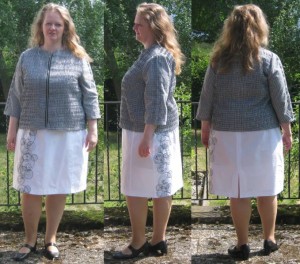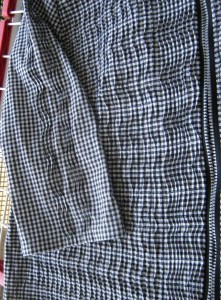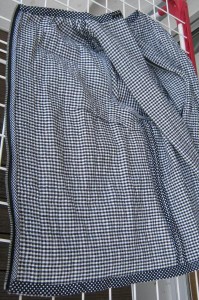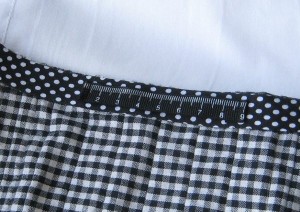Folded checkered jacket and how it was made
 Ich erwähnte es schon, die Jacke war dann doch etwas weniger „mal eben schnell“ als geplant, daher zeige ich hier, wie ich sie genäht habe.
Ich erwähnte es schon, die Jacke war dann doch etwas weniger „mal eben schnell“ als geplant, daher zeige ich hier, wie ich sie genäht habe.
I think I already mentionned it, the jacket was not as quick as planned, so I’ll show you what I did.
Der Ausgangspunkt für meinen Schnitt was Butterick B5927. Ich habe die Vorderteile von Version B genommen, habe die Schößchenteile aber angeklebt, so daß ich ein durchgehendes Schnitteil hatte. Die leichte Formung, die es hatte, habe ich dabei vernachlässigt. Und ich habe das Teil an der vorderen Mitte enden lassen, weil ich einen Reißverschluss verwendet habe und keine Knöpfe. Das Rückenteil ist im Orignal mit Mittelnaht, ich habe aber im Bruch zugeschnitten und auch hier die Taillenformung aufgegeben. Dafür habe ich im Vorderteil eine FBA gemacht und so einen Brustabnäher erhalten. Die Ärmellänge habe ich ausgemessen und auf meine Wunschläge gekürzt.
The starting point for my pattern was Butterick B5937. I used view A, but added the lower front piece directly to the upper front piece so I had only one front piece. I lost a bit of shaping that way. And I made the front part only to the middle, like view C, because I made a zipper instead of buttons. The back has a shaped seam in the middle which I skipped. I cut my back on he fold, again loosing a part of the shaping. On the other hand I made an FBA and added a breast dart that way. For the sleeves I tried the pattern on my arms and shortenend it to the lengths I wanted.
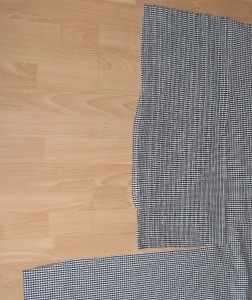 Danach habe ich schmale Falten (=Biesen) genäht. Ich hatte vorher verschiedene Faltenbreiten und -abstände getestet. Die Variante, die mir am besten gefiel war letztlich nicht möglich, weil ich dafür noch mehr Stoff gebraucht hätte. Ich habe die Falten jeweils ein Kästchen breit genäht und die Abstände variiert. Da ich den Stoff quer geteilt habe sieht man, wie viel Stoff diese erst wenigen Falten „gefressen“ haben.
Danach habe ich schmale Falten (=Biesen) genäht. Ich hatte vorher verschiedene Faltenbreiten und -abstände getestet. Die Variante, die mir am besten gefiel war letztlich nicht möglich, weil ich dafür noch mehr Stoff gebraucht hätte. Ich habe die Falten jeweils ein Kästchen breit genäht und die Abstände variiert. Da ich den Stoff quer geteilt habe sieht man, wie viel Stoff diese erst wenigen Falten „gefressen“ haben.
Then I started sewing tucks (pintucks). I had tested different widths of tucks and different spacings. My preferred version was not possible, because that would have required even more material. So I finally decided for „one check“ as depth of the tucks and varied the spacing. The picture shows only a fractions of the tucks needed for one front and you can see how much fabric that „eats up“.
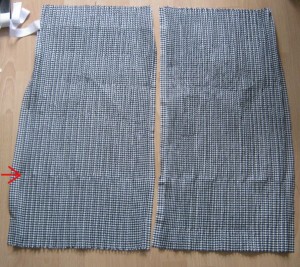 Anschließend werden die Falten wieder flach genäht und zwar zuerst auf Taillenhöhe.
Anschließend werden die Falten wieder flach genäht und zwar zuerst auf Taillenhöhe.
After that the folds are layed and sewn flat. I started on the waistline.
Anschließend werden die Falten abwechselnd in die eine und in die andere Richtung gelegt und immer wieder durch Quersteppen festgenäht. Auch hier hatte ich verschiedene Abstände vorher getestet.
 Then the tucks are layed flat with alternating directions on the fabric and sewn that way. Again I had determined the spacing of my topstitching on samples.
Then the tucks are layed flat with alternating directions on the fabric and sewn that way. Again I had determined the spacing of my topstitching on samples.
Durch diese Stepperei bekommt man nicht nur einen interessanten optischen Effekt, sondern auch einen Stoff der etwas stabiler und auch wärmer wird, als der ursprüngliche eher leichte Baumwollstoff. So wird aus einem Blusenstoff ein leichter Jackenstoff. Ich habe die einzelnen Schritte absichtlich nicht gebügelt, dadurch wird der entstehende Stoff sogar ein wenig elastisch.
The result is a fabric that does not only look interesting, but that also changes it’s quality. It becomes stronger and warmer without a lining. So I could transform a blouse fabric to something suitable for a light jacket. I did not press or iron after the different sewing steps, so the resulting material has even a bit elasticity.

Ich habe den Stoff zuerst gesteppt und dann zugeschnitten. Wobei ich auf Höhe des Brustabnähers die Quersteppungen erst mal weggelassen habe. Die Quersteppungen machen den Stoff ja fester und steifer, das wollte ich beim Abnäher nicht unbedingt haben.
I first topstitched the fabric and cut the pattern then. Only where the breast dart would be I left out the widthwise stitches. Those make the fabric a little stiffer and firmer which was not exactly what I wanted within the dart…
 Dann habe ich die Form des Abnähers mit einer Naht markiert, habe die restlichen Quernähte jeweils bis einige Stiche in den Abnäher hinein genäht und danach den Abnäher geschlossen.
Dann habe ich die Form des Abnähers mit einer Naht markiert, habe die restlichen Quernähte jeweils bis einige Stiche in den Abnäher hinein genäht und danach den Abnäher geschlossen.
Then I staystitched the shape of the dart, made my topstitching on the rest of the fabric only until I was some stitches inside the darf and closed the dart afterwards.
Die Vorgehensweise für den Rücken war ähnlich: Erst ein rechteckiges Stück Stoff nähen, dabei habe ich von der Mitte aus angefangen. Danach zuschneiden. Und dann habe ich noch zwischen die Falten in der hinteren Mitte kleine Abnäher gesetzt, um zumindest ein bißchen Taillierung hinein zu bekommen.
For the back I worked similarily: I started sewing the folds in the middle and worked then the tucks towards the sides on a rectangular piece of fabric. Then I cut my pattern and after that I added some thin darts between the middle folds to create a bit of waist shaping.
Im Grunde genommen alles ganz einfach, kostet nur etwas Zeit. Und Nähgarn, ich habe knapp 1000m AlterfilS120 verbraucht…
Basically it’s very easy, it takes only some time. And sewing thread. I’ve used nearly 1000m of Alterfil S120…
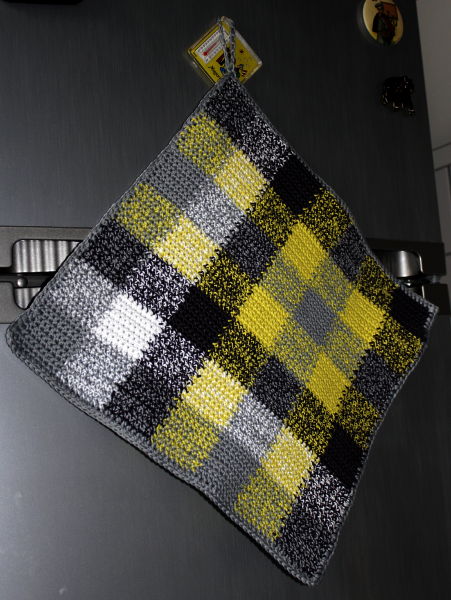 I do own like a zillion pot holders of all kinds. Some store bought, some carefully crafted… but if I look at what I use most often, then its the good old crocheted cotton model. They offer a better heat protection than all sewn ones (no matter if handmade or from a shop), I can fold them over for double protection, easily washable in the machine and can double as table mat to protect surfaces against the heat of a pot.
I do own like a zillion pot holders of all kinds. Some store bought, some carefully crafted… but if I look at what I use most often, then its the good old crocheted cotton model. They offer a better heat protection than all sewn ones (no matter if handmade or from a shop), I can fold them over for double protection, easily washable in the machine and can double as table mat to protect surfaces against the heat of a pot. Also habe ich mir einen neuen gehäkelt. Das Garn ist „Camilla“ von Woll Butt, das ich doppelt genommen habe. (Auswahlkriterium war die Farbe und daß ich eh bei Buttinette was bestellen mußte…) Karomuster sieht man, die Größe ist mit knapp 35cm Kantenlänge etwas arg groß, ich muß meine Haken dafür höher hängen, damit sie nicht auf den Herd hängen, aber sonst ist das so geworden, wie ich das haben will.
Also habe ich mir einen neuen gehäkelt. Das Garn ist „Camilla“ von Woll Butt, das ich doppelt genommen habe. (Auswahlkriterium war die Farbe und daß ich eh bei Buttinette was bestellen mußte…) Karomuster sieht man, die Größe ist mit knapp 35cm Kantenlänge etwas arg groß, ich muß meine Haken dafür höher hängen, damit sie nicht auf den Herd hängen, aber sonst ist das so geworden, wie ich das haben will.







